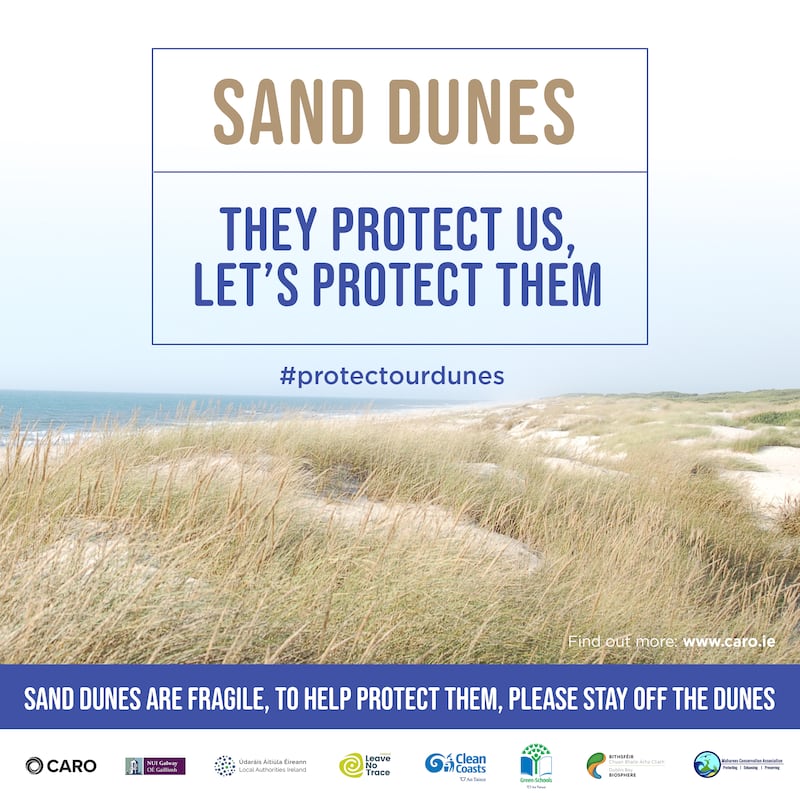An environmental campaign is to run throughout the summer highlighting the fragility of Irish sand dune systems and emphasising their importance in coastal protection, countering climate impacts and providing a habitat for unique species such as orchids and birds.
Climate Action Regional Offices (CARO) in collaboration with local authorities, NUI Galway, Leave No Trace, Clean Coasts, Green Schools and the Dublin Bay Biosphere launched the public awareness campaign on Saturday as part of World Sand Dune Day.
“In the past, some may have thought sand dunes were just nice places for the plants and animals. [But] there is a growing realisation they can be a big part of our fight against climate change and storm impacts. Coastal dunes are an excellent, flexible coastal protection,” said David Mellett regional director of CARO Atlantic Seaboard North.
Irish beaches and dunes have become so popular that they are being put under tremendous pressure, he said. “Where beaches can take a lot of coming and going, dunes are much more fragile. The tough plants that bind dunes in place are actually not suited to being walked on and die back very quickly with human trampling. The sand is then free to be blown away.”
Darragh Ó Sé: Mick O’Dwyer had a way of making you feel you were in on a secret with him
Trying out Lidl’s new Thermomix dupe: ‘I don’t take direction from a robot well’
Meghan Markle’s new podcast: An ego-fluffing conversation underlining the culture gap between Ireland and the US
The Return: In Ralph Fiennes’s new film, a minimalist take on The Odyssey, even the loincloths are skimpy
Olivia Jones, Clean Coasts officer for Sligo, Mayo and Donegal, said Ireland’s sand dunes “are rich and valuable habitats” protected at EU level and play a huge role in coastal protection, against coastal flooding and high winds.
“Unfortunately, due to their fragile nature, our engagement with sand dunes through recreational activity, such as walking, running and wild camping causes considerable damage,” she said, adding that the campaign was asking people to enjoy the beach and coastline but to “stay off the dunes”.
The vulnerability of the Irish coastline was confirmed in a 2020 study which found 20 per cent is at risk of erosion — with 6 per cent in immediate danger.
The two main dune types are marram grass “white” dunes and older “grey” dunes, landward of these. Overall Irish white dunes have been scored as being in an “unfavourable-inadequate” state, while Irish grey dunes status are in an “unfavourable-bad state” and trending towards further decline. A 2019 National Parks & Wildlife Service report attributes this dire situation to “pressures associated with recreation and coastal defences, which may interfere with local sediment dynamics”.
The Protect Our Dunes Working Group is exploring how collective action can ensure the progression, protection and resilience of young and mature dune systems. “This has led to the development of this awareness campaign which will run over the coming months to highlight the value and fragility of our sand dunes,” Mr Mellett said.
The campaign recognised that increased tourism and recreational use of beaches was welcome but said this needed to be managed in a way that respects and protects these natural assets, he added.
“The goal is to limit the damage to sand dunes from recreational activities along the coastline by raising awareness of the value, the types of activities that can damage the dunes and need to respect these ecosystems,” he said.
It will underline the consequences of walking on dunes — rather than sticking to designated pathways. This can trigger “blowouts” where part of the dune begins to disappear. Sand often ends up being blown on to land, buildings and roadways. This is in turn allows water from the ocean to encroach onshore and elevates flood risk.
The campaign will be visible across social media platforms of the project partners and some coastal community groups. A series of events including guided walks are being organised in conjunction with coastal communities.

A communication toolkit for coastal communities and organisations that can be downloaded through Trello — Further information is available on the CARO website















